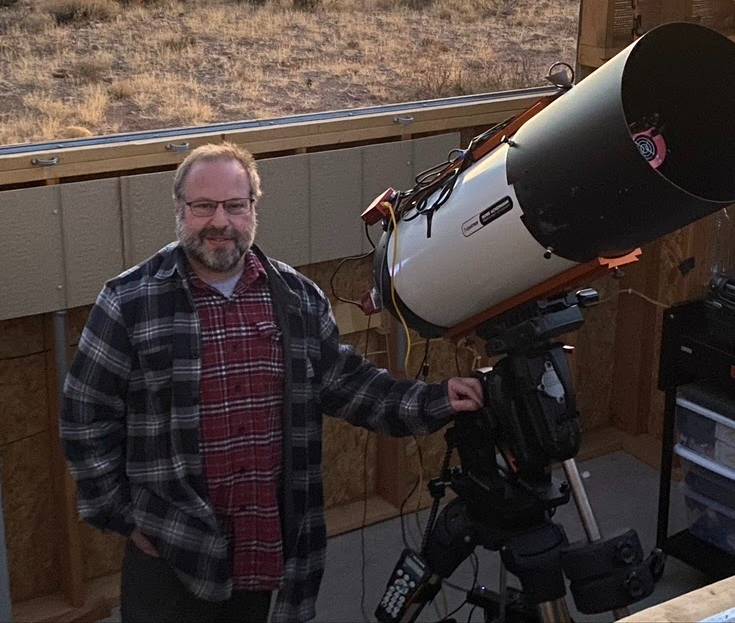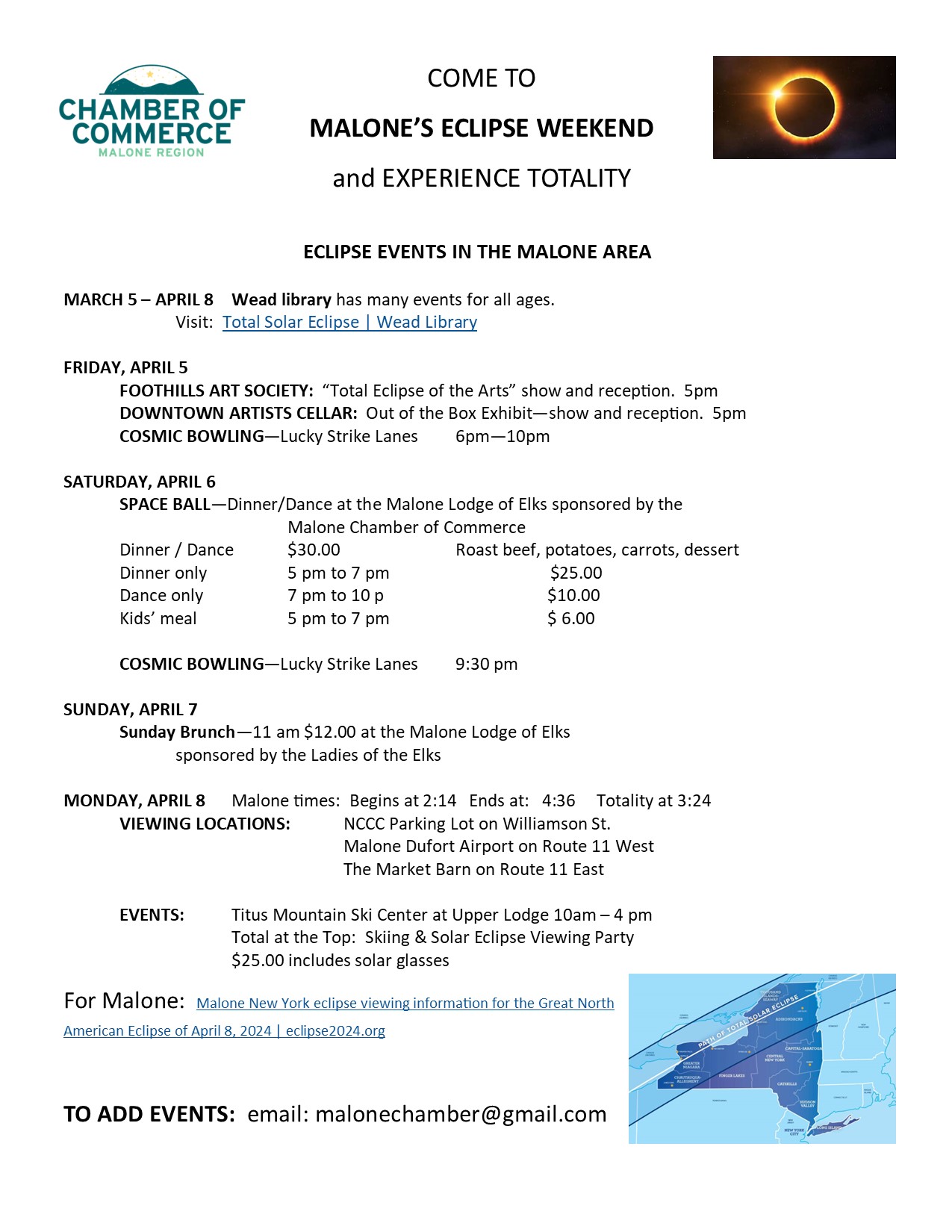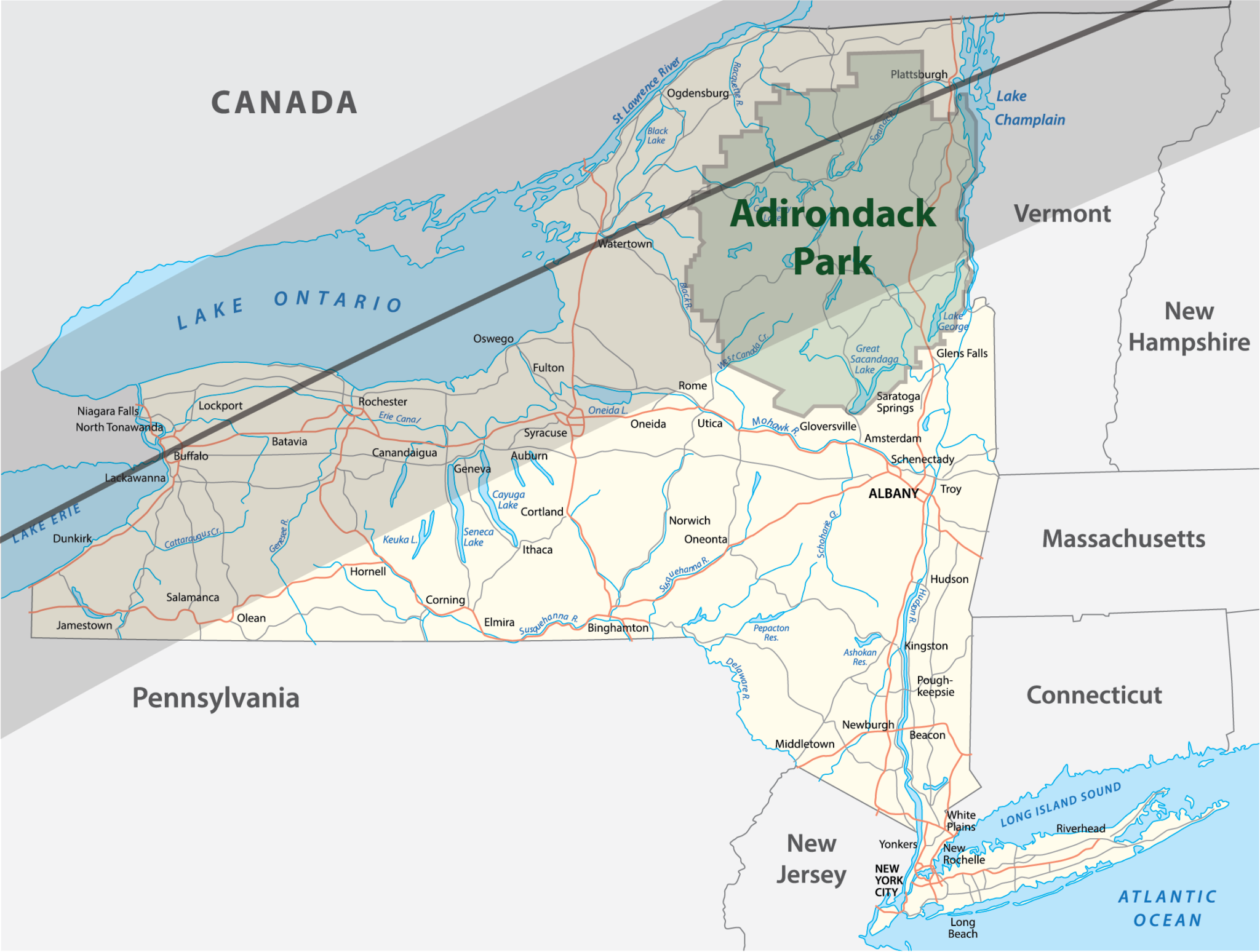2024 Solar Eclipse

On April 8, 2024, large portions of the Adirondacks and North Country will be directly in the path of totality for a Total Solar Eclipse. This is not only an amazing sight but a rare occurrence. In fact, it will be the first time the Adirondacks have ever been in the direct path of totality, and after 2024 the United States will not see another total solar eclipse for over 20 years.
To prepare and excite the college community for this incredible shared experience, here's some important information and resources, and details about eclipse events happening in our campus communities. Be sure to check back as more information will continually be added!
|
The Great Adirondack Eclipse A presentation by Seth McGowan, President of the Adirondack Sky Center & Observatory Seth McGowan, President of the Adirondack Sky Center & Observatory, describes the
"secret recipe" behind the upcoming April 8th Total Solar Eclipse destined to grace
the Adirondacks. He shares a number of perspectives on the upcoming eclipse, as well
as the history of eclipses within the Adirondack Blue Line. You will hear about the
impact to communities within the path of totality, and what is expected in the six-million-acre
park.
|
Frequently Asked Questions about Eclipse 2024
Being in the path of totality for a solar eclipse means you are in the direct path where the moon passes between the sun and Earth, completely blocking the sun. Places not in the path of totality only see a portion of the sun covered.
The video below offers an overview of the experiences people had during the 2017 total solar eclipse.
If your community is within the shaded area (between the outer red lines), you are in the path of totality for the April 8, 2024 eclipse. The closer to the blue center line, the longer you will be at totality.
See “What time will the eclipse take place?” for a list of some of the Adirondacks towns that are in the path, or use this interactive map to search your community.
Where you are on the path of totality dictates exactly when and how long you will experience full totality. Those closest to the center of the path will experience totality for over 3.5 minutes. View the time calculator for your community visit eclipse2024.org, and enter your town in the upper right corner.
The following chart highlights a small sampling of our communities to give you a quick snapshot of the timeline of the path. It is important to note that the exact timing may vary even within one community based on your location. If there is not a time listed in the second two columns, that indicates that your location is just outside of the path and will experience a partial eclipse that is in the high 90th percentile, but not a total eclipse. View printer-friendly PDF of timing per Adirondack community.
| TOWN | PARTIAL STARTS | TOTALITY STARTS | TOTALITY DURATION |
| Au Sable Forks | 2:13 p.m. | 3:25 p.m. | 3m 25s |
| Bloomingdale | 2:13 p.m. | 3:24 p.m. | 3m 32.1s |
| Blue Mountain Lake | 2:12 p.m. | 3:24 p.m. | 2m 40s |
| Crown Point | 2:13 p.m. | 3:26 p.m. | 1m 12.2s |
| Elizabethtown | 2:13 p.m. | 3:25 p.m. | 2m 55.7s |
| Essex | 2:13 p.m. | 3:26 p.m. | 2m 58s |
| Jay | 2:13 p.m. | 3:25 p.m. | 3m 21.9s |
| Keene | 2:13 p.m. | 3:25 p.m. | 3m 11.5s |
| Keene Valley | 2:13 p.m. | 3:25 p.m. | 3m 1.9s |
| Keeseville | 2:13 p.m. | 3:25 p.m. | 3m 25.4s |
| Lake Clear | 2:14 p.m. | 3:24 p.m. | 3m 32.7s |
| Lake Placid | 2:13 p.m. | 3:25 p.m. | 3m 21.1s |
| Lewis | 2:13 p.m. | 3:25 p.m. | 3m 8.0s |
| Long Lake | 2:12 p.m. | 3:24 p.m. | 3m 1.4s |
| Malone | 2:13 p.m. | 3:24 p.m. | 3m 14s |
| Minerva | 2:12 p.m. | 3:25 p.m. | 1m 23s |
| Mineville | 2:13 p.m. | 3:26 p.m. | 2m 23.1s |
| Moriah | 2:13 p.m. | 3:26 p.m. | 2m 7.5s |
| Newcomb | 2:14 p.m. | 3:25 p.m. | 2m 44.9s |
| North Elba | 2:13 p.m. | 3:25 p.m. | 3m 21.1s |
| North Hudson | 2:13 p.m. | 3:26 p.m. | 1m 59s |
| Olmstedville | 2:12 p.m. | 3:26 p.m. | 0m 56.8s |
| Paul Smiths | 2:12 p.m. | 3:24 p.m. | 3m 34.8s |
| Piercefield | 2:12 p.m. | 3:24 p.m. | 3m 32.3s |
| Saranac Lake | 2:12 p.m. | 3:24 p.m. | 3m 28.9s |
| St. Armand | 2:13 p.m. | 3:25 p.m. | 3m 29s |
| Ticonderoga | 2:13 p.m. | - - | – – |
| Tupper Lake | 2:12 p.m. | 3:24 p.m. | 3m 29.8s |
| Upper Jay | 2:13 p.m. | 3:25 p.m. | 3m 19.8s |
| Vermontville | 2:13 p.m. | 3:24 p.m. | 3m 33.3s |
| Wilmington | 2:13 p.m. | 3:25 p.m. | 3m 25.4s |
In the path of totality, where the Moon completely covers the Sun, the sky will become dark, as if it were dawn or dusk. For those who only experience a partial solar eclipse, the sky will appear slightly darker than it was before the eclipse, depending on how much the Moon blocks the Sun in their location.
You can expect the temperature to drop about 10 degrees Fahrenheit (5 degrees Celsius) depending on the humidity and cloud cover at your location.
During a total solar eclipse, you will see multiple unique features as the eclipse progresses.
- Partial eclipse: As the Moon passes between the Sun and Earth, at first it does not completely cover the Sun. The Sun appears to have a crescent shape.
- Shadow bands: Shadow bands are rapidly moving, long, dark bands separated by white spaces that can be seen on the sides of buildings or the ground just before and after totality, though they can be very faint and difficult to photograph.
- Baily's Beads: As the Moon continues to move across the Sun, several points of light shine around the Moon’s edges. Known as Baily's Beads, these are light rays from the Sun streaming through the valleys along the Moon's horizon
- Diamond Ring: Baily’s Beads will begin to disappear until eventually, only a single bright spot will remain along the edge of the Moon’s shadow. This bright spot resembles the diamond in a giant diamond ring formed by the rest of the Sun’s atmosphere.
- Totality: Totality is when the Moon completely blocks the bright face of the Sun. This is the only stage of the eclipse that you can view with your naked eye. This stage can also reveal the chromosphere (a region of the solar atmosphere, appearing as the thin circle of pink around the Moon) and the corona (the outer solar atmosphere, appearing as streams of white light).
The Sun’s surface is so bright that if you stare at any portion of it, no matter how small, it produces enough light to damage individual retinal cells. It takes a few seconds for this to happen, but afterward, you will see a spot as big as the solar surface you glimpsed when you look away from the Sun at some other scenery. Depending on how long you gazed at the Sun and how badly the retinal cells were damaged, this spot will either fade away in time or remain permanent. You should never assume that you can look away quickly enough to avoid eye damage because every person is different in terms of their retinal sensitivity, and you do not want to risk being the one who damages their eyes just to try to look at the Sun.
When the bright photosphere of the Sun is completely covered, only the faint light from the corona is visible, and this radiation is too weak to have any harmful effects on the human retina. There is a misunderstanding that during a total solar eclipse, when the Moon has fully blocked the light from the Sun, there are still harmful rays that can injure your eyes. This is false.
During other types of solar eclipses, viewers must wear solar viewing or eclipse glasses or use an alternative viewing method the entire time, as at least part of the Sun is always visible. During a total solar eclipse, viewers should take those protective measures before and after the Sun’s visible disk is completely blocked. However, once it’s completely blocked – called totality – viewers can look directly at the eclipse without any special eye protection.
Yes, but you need to have the specialized eclipse filter between your camera and the Sun. See the American Astronomical Society website for more detailed instructions.
Check out this Eclipse 2024 playlist on Spotify:



